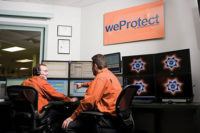It’s hard to go about daily life now without hearing about “the cloud.” Apple, Amazon, Dropbox, computers and even your local bank now offer cloud storage.
People use the cloud every day, whether they realize it or not, says John Szczygiel, executive vice president and chief operating officer, Brivo Systems LLC, Bethesda, Md. “They are being trained that they shouldn’t have to install software. When was the last time you put a disk into a computer?”
In the access control space as well, customers are interested in cloud options and are more open to the concept.
“We’ve seen the most penetration in industries where they have some Internet connectivity but don’t have their own WAN in place,” says David Barnard, director of dealer development, RS2 Technologies LLC, Munster, Ind. “It is a lot easier just to point the thing skyward and connect to the cloud and be able to log in from anywhere, whether a desktop or iPad.”
Unlike the hosted or managed access of the past, “cloud” access is primarily a browser or Web-based format, which allows more dealers and integrators to get in on the opportunity.
“In the past, the dealer had to host the server themselves and have an investment in infrastructure,” says John Smith, senior channel marketing manager, Honeywell Security, Melville, N.Y. “In most cases the dealers having success were the ones with central stations who had the equipment and bandwidth. The cloud offers much greater economy of scale. The dealer doesn’t have to make the same level of investment; they simply leverage space on a cloud network. Their cost is much lower than if they had to install it and manage it themselves.”
What Is the Buzz About?
The cloud is everywhere now. Yet, if you polled people on the street, probably not three in 10 could actually define what it means. Even within the security industry, definitions vary. For manufacturers and integrators coming from the physical security space it is simply hosted or managed access redefined. For those coming from the IT space, the definition involves specific requirements.
“Cloud access control is a hosted access control system where the main software that runs the system is sitting out at a remote location from the client’s property,” says integrator J. Matthew Ladd, president and COO, The Protection Bureau, Exton, Pa., a member of Security-Net. “A lot of cloud is hosted and managed. The hosted part is that I have the software. The managed is who actually adds cards, puts in schedules and runs reports.”
Is cloud-based simply the new incarnation of hosted services? “In truth I do see it that way, but it is a marketing term that generates interest from end users,” says Richard Goldsobel, vice president, Continental Access, a division of NAPCO Security Technologies Inc., Amityville, N.Y. “I had a client that was an IT guy and as soon as I mentioned cloud, the job was sold. It was like I flipped a switch. He knew exactly what it was and became very excited and impressed.”
While cloud as a marketing term is a positive thing for sales, be careful, Szczygiel cautions. “There are quite a few liberties taken with these definitions and they can become marketing terms with little value. We like to refer to the National Institute of Standards and Technology (NIST) definitions, which define cloud computing as a ubiquitous, convenient and an on-demand network access to a shared pool of configuring network resources. In the IT space the term cloud computing means something to people. It means this NIST definition. A dealer may be setting up a special computer just to run a particular user and on demand self-service. They may have picked up a customer’s access system and moved it remotely. You could loosely define that as cloud, but it wouldn’t stand up to NIST.”
One thing everyone agrees on, however, is that the current incarnation of cloud access uses a mobile, Web- or browser-based format.
“What has changed is greater accessibility for the client,” Ladd says. “Cloud services are all browser-based, which makes it far more efficient [and convenient].”
Smith agrees. “The consumer market is driving us to the cloud. They don’t want to have a dedicated PC. Most people today check news, weather, Facebook on their mobile devices and they want to be able to add security to that routine.”
In fact, several manufacturers are developing cloud-based applications, or “apps” for specific functions such as locking/unlocking doors and visitor access.
The Changing Model
For the integrator or dealer, cloud access presents an opportunity to generate recurring monthly revenue (RMR). Even those who have not offered a central station or monitoring service before can now consider getting into it. Nevertheless, it does require a change of thinking, structure and staffing.
With its reliance on mobile and Web access instead of a local client/host setup, cloud gives integrators a selling point for the end user, says Allen Pante, director of the electronic division, Phil & Son Inc., Crown Point, Ind. “When you consider the proposal of us doing cloud as opposed to onsite, usually we are at least 20 percent lower in cost because we don’t have all the hardware and software to install. The lifecycle of the product allows for software and firmware upgrades to be included with the package. And naturally our costs can be lower because we follow that RMR model.”
The cloud is just the medium, however, says Steve Dentinger, director of sales and marketing, Keyscan Inc., Whitby, Ontario, Canada. The real fundamental questions for the integrator are how to provide that service over the cloud. Are they going to manage or host it, and how are they going to structure those services to create RMR?
“What type of service do you want to provide as an integrator?” Dentinger asks. “Hosted just takes the computer and software away from the traditional access customer and puts it in the hands of the integrator to provide all the software updates and backups that should be performed at the computer. Managed, on the other hand, generates significantly more work for the integrator, but also more RMR. The benefit is true turnkey. But it is a unique integrator that can deliver those services. They have to have almost a call center structure. The vast majority of our integrator customer base goes to the hosted access control side.”
Jason Ouellette, product line director for access control, Tyco Security Products, Westford, Mass., sees a definite interest from integrators that were not previously in the RMR mindset. “Certainly the bigger integrators are the ones that already have an established RMR model. However, in the past 12 months we have started to see adoption by newer players looking into that space.”
However, switching from a traditional business model to an RMR model takes careful planning, Smith relates. “Integrators need to make sure they know how to sell the service-based model and train their salespeople on it. The business needs to be behind it, commissioning salespeople on RMR, not just traditional installations. Don’t think you are going to go out tomorrow and start selling this without getting the rest of the team on board.”
Barnard agrees. “Those that have been the most successful are the companies that have actually tried to put together a program targeted at this type of sale and market. Companies that have tried to loosely bolt it onto their existing operations haven’t been as successful.”
Many dealers and integrators approach cloud access with a per-door model, service bundling, or ala carte menu of service.
“There are many different ways of pricing out cloud services,” Ladd shares. “One is by the door. One is by services provided. We give them so many reports a month, then add additional charges. But if it is hosted, the client can run as many reports as they want. What I really want to see is no activity because that all takes time.”
Pante’s company charges a site fee with an unlimited number of sites that can be added, then charges per door. “It is one site fee, then however many doors they would like; and they have the ability to add and delete cards and administer the system if they wish.”
The hosted model is a popular one with customers as well as integrators, says integrator Chris Diguardi, president, Key-Rite Security, Denver, Colo. “Ninety-five percent of our customers manage the system themselves. For the 5 percent that don’t, we charge a 25 percent premium for managing it for them.”
Cloud has absolutely opened up the industry, Smith adds. “The barrier to entry was much higher in the past, from the dealer’s perspective. Now any dealer or integrator can get into that space with little investment. Traditional systems charge for installation, labor, time and equipment. Looking at cloud-based, the integrator can take that and bundle all those pieces and offer it at a much lower cost. Now they can get three- or five-year contracts and calculate the cost of ownership to really figure out what the return on investment will be for each of the accounts. That is a different business model.”
Calculated Risks
For many dealers and integrators the decision whether to host the cloud access in-house or outsource it is an easy one. Those who have a central station or other RMR service delivery model already in place often can transition smoothly to adding access control to their menu of options.
For others, there is a confusing array of options for how to get into the business of cloud access. Some manufacturers offer cloud storage or hosting for the dealers to then sell at an up-charge to their customers. Other options include third-party hosting or SaaS providers.
“The difference is whether they host their own system in their own location or make use of a third party SaaS provider who carries all that workload for them and allows them to focus on going out and selling to their end user customer,” Szczygiel says. “An integrator may look at this and think ‘I can do this myself.’ The perception is they will be more profitable or in control. But they take on a number of responsibilities when they decide to host their own infrastructure. As long as they are prepared, it could be a good way to go. But they need to consider their pay back. Even if they are using a service provider, there are significant outlays in terms of software and resources.
“With SaaS the integrator doesn’t have as much control over the infrastructure, but they are profitable from door number one. If they do it themselves they may have to sell hundreds or thousands of doors before they break even on the infrastructure investment,” Szczygiel says.
Another consideration for integrators and their customers is whether the cloud system has an “out of the cloud” counterpart. For example, Keyscan’s system can be hosted by the manufacturer, moved to the integrator’s facility if desired, and eventually converted to a traditional non-cloud system for the customer if they grow to a point where they want full control in-house.
“Some of our integrators were finding it difficult to sell systems to end users that didn’t have an ‘out of the cloud’ solution,” Barnard adds. “When companies grow they like to have the option to bring the system back in house if they want to.”
Whatever path they choose, manufacturers and integrators alike suggest someone just starting out in cloud access do their research carefully.
“Find a product in the access control market that you are happy with from a manufacturer that will support you and then learn that product very well,” advises Chris Gingerich, manager of electronic access control for Integrator Safeguard Security and Communications Inc., Scottsdale, Ariz. “You are much better off picking one and understanding it.”
Dentinger agrees. “I would advise them to thoroughly investigate the access control manufacturer. Unlike traditional access where they could potentially move to another line, once they get entrenched with a cloud solution it is difficult to pull away. This is going to be a very long-term relationship.”
For those who can find the right path, the rewards can be great.
“The biggest thing is don’t be afraid of it,” says Paul Bodell, president and CEO, ECKey Smartphone Access Systems, Lancaster, Pa. “Progressive integrators want satisfied customers and everyone wants less hassle to deal with. Offloading access to the cloud-based environment that they can get anywhere, any time accomplishes that. And for the integrator, the margin they will realize will be so far beyond just a hardware sale it will reshape the nature of their business.”
The Real Deal
Some integrators have been offering “cloud” (or hosted or managed) access control for 20 years. Others have been in it for just a few months. However, all of them had very specific reasons for choosing the paths to cloud access that they did.
“We have been managing access control systems since the mid ‘90s using dial-up initially,” says Chris Gingerich of Safeguard Security and Communications Inc. “Now we do actually have our own data center in house attached to our central station and all of our cloud access runs out of that. This allowed us to have control over what is going on and respond if there is any kind of issue.”
J. Matthew Ladd, president and COO, The Protection Bureau, also remembers the dial-up days. “What has happened with the cloud is that now I can provide even more services like remote locking and unlocking. It is better for the client now than ever before. If there is an issue with their system, a technician doesn’t have to roll a truck to the site. They can just get on the system remotely and do the diagnostics.”
Not having to “roll a truck” was a major factor in Phil & Son Inc.’s decision to get into cloud access in 2005, says Allen Pante, director of the electronic division. “One of the biggest reasons we got into this was the service aspect. We started the business in 1999 and by the time we got to 2005 it was getting labor intensive with hardware failures and PCs and servers needing attention. The access control hardware was fine but we were spending too much time with IT departments trying to maintain operating systems. Any time there was a question from a client we would have to get a tech on site and go over the system with them. It started costing us more than it was worth over the life cycle of the system. Cloud access allows us to remotely provide support without leaving the office.”
Chris Diguardi, president, Key-Rite Security, also came from the onsite installation side of the business. “We didn’t have any RMR prior to going with Web hosted. For us it started as a convenience for us not having to load software. Then we started thinking if every customer was paying us per month for this it would be a big deal.”
Dealer Tom Cychosz, chief operations officer and principal, Cloud 9, saw an opportunity beyond just his business and customers. “We figured out a way to take RS2 software and host it as a server in the cloud. We do sell some hardware but more than 90 percent of our sales is taking access control and giving dealers the ability to manage it from the cloud. They can try it out without the outlay themselves.”
Kingdom Security LLC, La Porte, Texas, is new to the cloud access scene, starting their service last summer. “We started looking into this because a customer wanted the nifty features but didn’t want to pay for a $30,000 system. We try to stay away from alarms and this was a good way for us to get into the RMR side of the business without having to focus on that side of it.”







